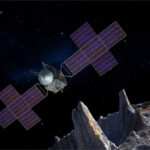“Applying to Psyche Inspired was one of the best decisions I’ve made,” said Psyche Inspired intern Ryan Powell, a music major from Albion College in Michigan. “If you’re an open-minded, art- and science-loving, motivated space nerd, then you should consider applying. Not only will you personally gain from the experience, others will gain from the things you create as well.”
Participants in the program are also encouraged to collaborate with their peers, enabling them to develop skills and relationships with people around the country with diverse academic backgrounds and artistic abilities.
“The Psyche Inspired program was such an awesome experience to be a part of, not only being involved with a NASA mission, but meeting and collaborating with other artists,” said Psyche Inspired intern Jessika Raisor, an animation major from the Columbus College of Art and Design in Ohio.
Previous Psyche Inspired interns have come from a wide range of majors including astronomy, astrobiology, engineering, computer science, geology and public policy, in addition to traditional fine arts and graphic design fields.
“I was worried I wouldn’t fit in when I applied since I didn’t have a science background, but that wasn’t the case at all,” said Psyche Inspired intern Addison Rizer, an English major at Arizona State University. “We all brought our own skills to the mission; we were all there to learn and grow together. It was an incredible experience.”
The Psyche Mission
Psyche, an asteroid orbiting the sun between Mars and Jupiter, is made almost entirely of nickel-iron metal. As such, it offers a unique look into the violent collisions that created Earth and the terrestrial planets.
The Psyche spacecraft is planned to launch in August 2022 and travel to the asteroid using solar-electric (low-thrust) propulsion. After flying by Mars in 2023 for a gravity assist, the spacecraft will arrive at Psyche in 2026 and spend 21 months orbiting the asteroid, mapping it and studying its properties.
The scientific goals of the Psyche mission are to understand the building blocks of planet formation and explore firsthand a wholly new and unexplored type of world. The mission team seeks to determine whether Psyche is the core of an early planet, how old it is, whether it formed in similar ways to the Earth’s core, and what its surface is like.
The spacecraft’s instrument payload will include a magnetometer, a multispectral imager and a gamma ray and neutron spectrometer. The mission will also test a sophisticated new laser communications technology, called Deep Space Optical Communications (DSOC).
The Psyche Mission is part of NASA’s Discovery Program. Psyche Principal Investigator Lindy Elkins-Tanton is the director of ASU’s School of Earth and Space Exploration. Other ASU researchers on the Psyche mission team include Jim Bell (deputy principal investigator and co-investigator), David Williams (co-investigator) and Catherine Bowman (co-investigator and student collaborations lead).
The mission is led by Arizona State University. NASA’s Jet Propulsion Laboratory is responsible for the mission’s overall management, system engineering, integration and test, and mission operations. Maxar Space Solutions, formerly Space Systems Loral, is providing a high-power solar electric propulsion spacecraft chassis.



